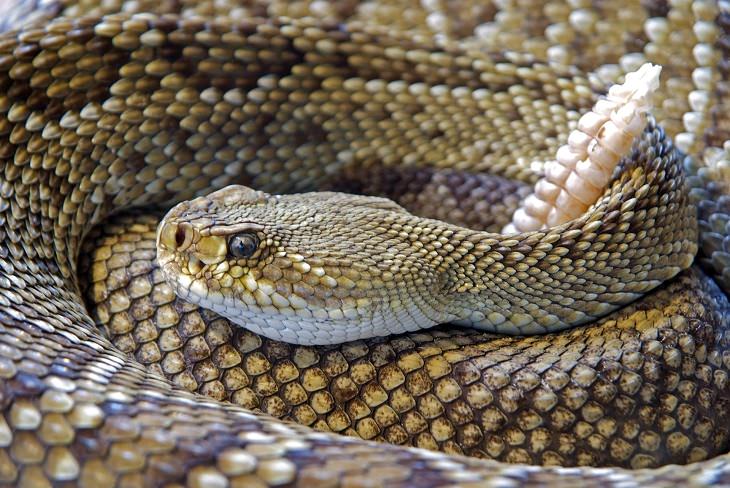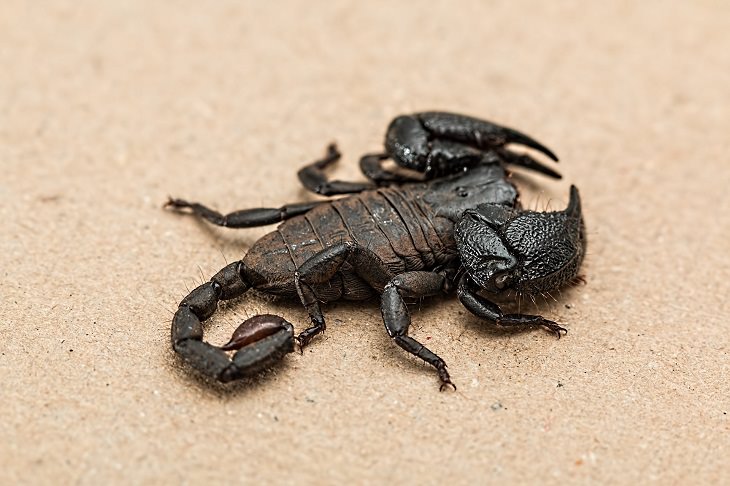
When you're out in the wilderness, there's every possibility that you'll encounter a potentially dangerous creature. If that happens, what do you do? Luckily for you, the following guide is full of helpful information that could help save your life, should you find yourself in a wild and sticky situation one day.

If it doesn’t see you: Take yourself to someplace safe very slowly.
If approached: Don’t run! The fastest man on Earth cannot outrun a bear. Stand your ground and avoid making direct eye contact. Yes, this takes some serious guts, but it could be the difference between life and death. Speak softly in a monotone voice and wave your arms around gently.
If attacked: If the above doesn’t work, then it’s time to play dead. Curl up into a ball on your side or lie down on your stomach.
Prevention: Pepper spray can be used if you’re within 25 feet of the bear.

If it doesn’t see you: Walk away slowly without making direct eye contact.
If approached: You can’t outrun a wolf, so why waste your much-needed energy? Make yourself look big and intimidating, but don’t show your teeth.
If attacked: Grab a rock, stick, or camp gear and aim for the animal’s nose. Remain upright and protect your face and throat.
Prevention: Keep your camp clean and make sure that all odorous food items are well sealed.

If it doesn’t see you: Back away slowly, making as little noise as possible.
If approached: Puff yourself up, make a lot of noise, and throw stones. However, don’t turn your back or crouch down. Slowly create a distance between yourself and the cat so that you’re not intruding on its kill or litter.
If attacked: Fight with anything you can get a hold of and aim for the cat’s eyes.
Prevention: hike in groups and carry a sturdy walking stick.

If approached: Coyotes are curious animals, and unlike wolves, they have been known to venture into metropolitan areas. If you cross paths with a coyote, act aggressively, be noisy, and throw things at them. Ignore that instinct to turn around and run. Make yourself appear larger and back slowly away while maintaining eye contact.
If attacked: Kick, push, and punch any part of the coyote that you can make contact with. If possible, try poking it in the eye.
Prevention: Luckily for us, coyotes are more likely to run away than to fight. However, when humans feed them, they become less fearful. In other words, never feed coyotes!

How to identify one: If you see a raccoon staggering about, sporting matted hair, and frothing at the mouth, it probably has rabies. Walk in the opposite direction and call your local wildlife control as soon as possible.
If bitten: Wash the wound with soap immediately, then get yourself to the closest hospital.
Prevention: Keep your trash cans sealed, garage doors locked, and chimney pipes blocked off. Also, get your pets vaccinated against rabies.

If you find yourself in invested waters: Don’t make too much noise or splash about as this is only going to draw some unwanted attention.
If approached: Try to play dead by bobbing about in the water. Sharks are less likely to go after a dead target, but that doesn’t mean that they won’t.
If attacked: Try to punch the shark in the nose or gouge its eyes. By putting up a fight, the shark might eventually decide that you’re not worth the effort.
Prevention: Stay out of murky water, and avoid wearing bright colors and shiny jewelry while swimming as the sharks might confuse you for bait fish. If you have a cut that is bleeding, don’t go in the water as sharks can smell it from miles away.

If you find yourself in infested waters: Stay calm as sudden jerky movements will just attract these prehistoric reptiles. Swim, preferably underwater, towards the shore, using breaststroke for minimal splashing.
Prevention: If you can’t resist the urge to take a dip in crocodile infested waters, at least avoid backwaters and inlets where they’re more likely to be lying in wait.

If you see one: get out of its path. Don’t worry, the jellyfish won’t come after you as they just drift along with the tide.
If stung: the toxicity of the venom, depending on what type of jellyfish you have been stung by, may hinder your ability to swim, so call for help and make your way towards the shore. Avoid rubbing the sore as this could release more venom into your body. Neutralize the venom by using vinegar or baking soda.
Prevention: Stay out of the water when the current is flowing towards the beach.

If you hear a rattle: There’s a rattlesnake nearby and it’s annoyed by your presence.
If you see one: Stay back. Rattlesnakes are shy creatures, but they will attack you if they feel threatened.
If you’re bitten: Get yourself to the nearest hospital as soon as you can. The longer you leave it, the more likely it is that you’ll die.
Prevention: Always wear sturdy boots when hiking in the great outdoors. Stay on clear trails and always scan the area in front of you. Use extreme caution when placing your hands or feet on or among rocks and crevices.

If you encounter one: Ignore it and walk away. If you start messing with it, there’s a chance that you’ll be at the end of a painful and/or lethal sting. Scorpions will attack anything that gets too close to them.
If stung: Most scorpion stings in the U.S. cause only mild symptoms, such as pain and warmth at the sting site. However, if you’re stung by a bark scorpion – native to Arizona, New Mexico, and the California side of the Colorado River – it can be a life-threatening situation. Get yourself to the hospital as soon as possible.
If you encounter a swarm of angry bees: Duck, cover, and run for the hills. These bees, also known as killer bees, are very aggressive, easily provoked, and fiercely territorial. They attack in swarms.
If attacked: Run as fast as you can. The U.S. Department of Agriculture recommends pulling your shirt over your head to protect your face as you run for shelter. If you have been stung more than 15 times, are feeling sick, or are allergic to bee stings, seek medical help immediately.
How to remove the stingers: Don’t use tweezers or your fingers as this will only squeeze more venom into your wounds. The USDA recommends scraping the stingers out sideways using a fingernail, dull knife, or any other straight-edged object.

If it doesn’t see you: Back away slowly, making as little noise as possible.
If approached: Make loud noises, a lot of movement, and stand as tall as possible in order to try to intimate the lion. Don’t run or curl up in a fetal position.
If attacked: Fight for your life. Find your animal instincts and attack it with rocks, sticks, or anything else you can get your hands on. You can even try throwing sand in its eyes. Protect your neck and head as much as possible.
Prevention: Don’t go out into the bush alone, don’t leave odorous foods lying about your camp, and make as much noise as possible so that the lions know you’re there.

If it doesn’t see you: Distance yourself from it as much as possible, whether you’re walking or canoeing.
If approached: Try to find a tree to climb or a bush to hide in. Standing your ground against an angry hippo isn’t going to do much good.
If attacked: Fight back obviously, but there’s probably not much you can do to fight off a furious hippo.
Prevention: If you’re canoeing, give the hippo plenty of space. If you’re walking, avoid thickets where hippos might be resting. Listen out for the call of an oxpecker bird as this is a warning sign that there might be hippos about.
Related Articles:
Why Do Some People Get Bitten More By Mosquitoes?
9 Animals That Have Ridiculously Long Lifespans